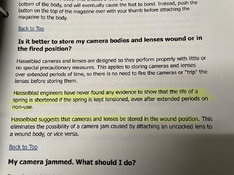I don't intend to embarass you or put you on the spot, but can you point to a specific Hassleblad document that recommends storing the casmera/lens cocked? I understand that it removes the chance of jamming the camera by attempting to remove/replace a lens when either lens or body is uncocked.
I just reviewed the instruction manuals for 1000F, 1600, 500C and CM, 500 C, 503 CW and CX.
The 1000F recomends releasing the shutter for storage:
View attachment 346499
All of the 500-series user manuals discuss that the body and shutter must be cocked to remove/replace and specify how to correct if one or the other has been released... but no mention that I've seen on storage.










